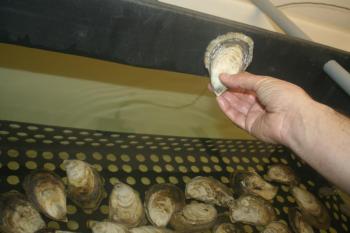Bacteria linked to illness in tourist
An out-of-state visitor recently became ill with Vibrio parahaemolyticus, a bacteria living in the Damariscotta River and in other brackish water, which infects oysters and hard-shelled clams. Soft-shelled clams are apparently not vectors for the bacteria, and cooking kills the bacteria, so deep-fried oysters and other cooked oysters and clams are safe, according to the Maine Department of Marine Resources. But public health officials said raw oysters from the Damariscotta River are no more likely this year to be affected than in past years: The bacteria involved is more prevelant, but the state has protocols in place.
The single illness was reported in August, and was traced back to Damariscotta River oysters, said Public Health Director Kohl Kanwit, who covers shellfish sanitation and management at the Boothbay Harbor office of the Maine DMR. Subsequent tracing led investigators back to one harvester and three dealers.
Vibrio parahaemolyticus lives in the water of the Damariscotta River, and especially owing to last year’s warm winter and this year’s hot summer, the bacteria population in the river has exploded, Kanwit said. When oysters and hard-shelled clams are taken from the water, they stop filtering water, and the bacteria count inside their bodies goes up.
Damariscotta River’s expected warm temperatures in 2016 caused the DMR to make new rules about handling oysters during harvesting and at the dealerships. “That’s just the kind of conditions Vibrio likes best,” Kanwit said. A new management plan was put into effect this season to keep the shellfish as healthy as possible, by requiring harvesters to get the bivalves onto ice within two hours, rather than the previously required 18 hours, and to keep them cold until they reached dealers, who were also required to keep them cold. Mandatory classes teaching the new handling protocols were given last winter, and all harvesters and dealers were required to turn in a management plan by March 1. The protocols are in effect from May through October.
During that time, recreational harvesting is prohibited, as is sale of both American and European oysters and hardshell clams from homes. All harvesters were required to submit a Vp Control Plan, and to keep shellfish cold, and take records of the air temperature during the harvest and transport.
Kanwit said the harvester had taken the mandatory Vibrio management class, offered several times last winter, and had submitted a management plan, but didn’t follow it. None of the dealers had taken the class, as required by the state. They will be part of a make-up class, also open to others, which will take place on Sept. 30, even though the harvesting period will end in October. She said enforcement action had been taken and referred the Boothbay Register/Wiscasset Newspaper to the local Marine Patrol officer who handled the investigation.
Lt. Danny White of Marine Patrol said the harvester was George Faux, and he was summonsed for violating shellfish regulations; his license was not suspended. The dealers are required to take the make-up class offered on Sept. 30. White said he could not name the dealers because the investigation was still under way. Anyone else interested in taking the class can email angel.ripley@maine.gov to register. Kanwit said the training will be required annually, so taking the class in September does not exempt harvesters from having to take the class over the winter of 2017, for the upcoming season.
Kanwit said the patient has recovered.
According to the Centers for Disease Control, symptoms of Vibrio parahaemolyticus infection usually occur within 24 hours after ingesting the bacteria, and may include watery or bloody diarrhea, abdominal cramps, nausea, vomiting, fever, and headache. The illness subsides in one to seven days, and severe complications are usually limited to people with compromised immune systems. Treatment is usually not necessary.
Last year, there were 4,500 cases reported nationally, but because the illness only lasts for a few days, the CDC believes that many other cases go unreported. The bacterium can also cause wound infections and septicemia, usually among oyster shuckers who may accidentally cut themselves while handling the bivalves.
Kanwit said that she has been out on the water observing oyster harvesting several times this year, and said that most people are diligent about making sure their shellfish are healthy. “Most people are doing everything they can do to follow the rules and help prevent illness,” she said. “This was an isolated case, involving a single illness.”
However, she pointed out, “Eating raw shellfish is never safe. People who are ill or have compromised immune systems should avoid raw seafood.”
Event Date
Address
United States
























